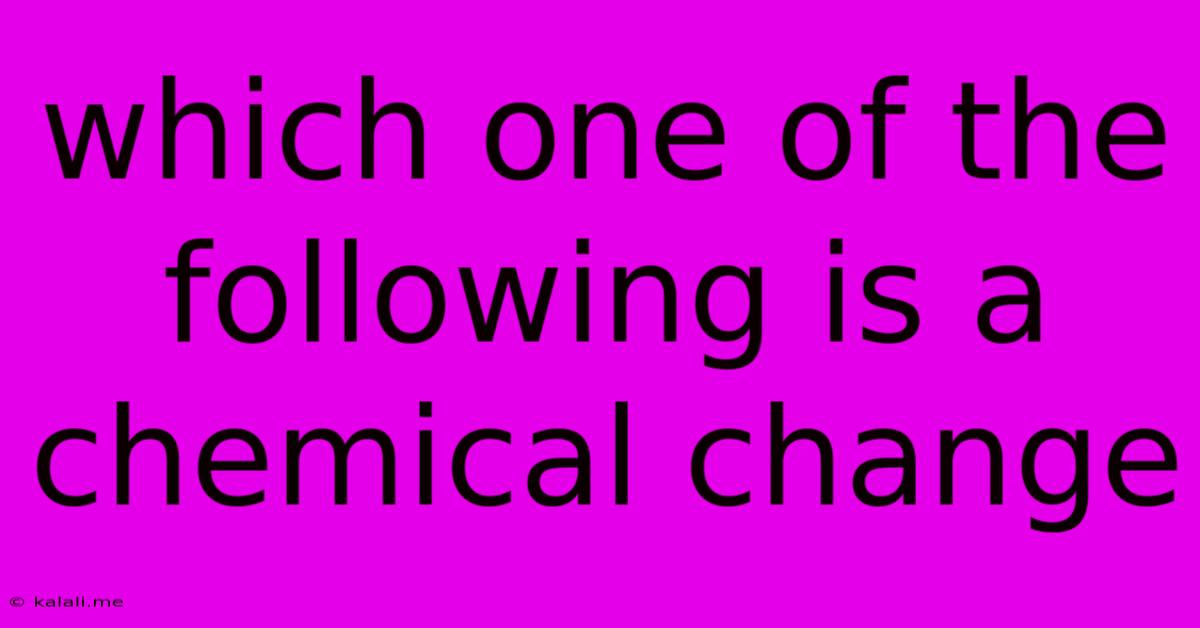Which One Of The Following Is A Chemical Change
Kalali
Jun 12, 2025 · 3 min read

Table of Contents
Which One of the Following is a Chemical Change? Understanding Chemical vs. Physical Changes
This article will delve into the fascinating world of chemistry, specifically differentiating between physical and chemical changes. We'll explore several examples to help you confidently identify a chemical change. Understanding this distinction is crucial in various scientific fields, and even in everyday life. By the end, you'll be able to easily determine which of a set of scenarios represents a chemical change.
What is a Chemical Change?
A chemical change, also known as a chemical reaction, is a process that results in the formation of new substances with different chemical properties. This transformation involves the rearrangement of atoms and the breaking and forming of chemical bonds. Key indicators of a chemical change include:
- Formation of a gas: Bubbles or fizzing often signify the release of a gas.
- Formation of a precipitate: The appearance of a solid from a solution.
- Change in color: A significant and unexpected color shift often points to a chemical reaction.
- Change in temperature: Either an increase (exothermic) or decrease (endothermic) in temperature can accompany a chemical reaction.
- Change in odor: The production of a new and distinct smell.
- Irreversibility: Many chemical changes are difficult or impossible to reverse easily.
What is a Physical Change?
In contrast, a physical change alters the form or appearance of a substance but doesn't change its chemical composition. Examples include changes in state (melting ice, boiling water), shape, or size. The substance remains the same chemically, just in a different form.
Examples to Illustrate the Difference
Let's consider some scenarios to highlight the distinction:
-
Scenario 1: Melting an ice cube: This is a physical change. The water molecules remain H₂O; only their arrangement changes from a solid to a liquid.
-
Scenario 2: Burning wood: This is a chemical change. Wood (primarily cellulose) reacts with oxygen in the air to produce ash, carbon dioxide, water vapor, and other gases. The chemical composition has fundamentally altered.
-
Scenario 3: Dissolving sugar in water: This is a physical change. The sugar molecules are dispersed in the water, but they retain their chemical identity. Evaporation of the water would leave the sugar unchanged.
-
Scenario 4: Rusting of iron: This is a chemical change. Iron reacts with oxygen and water to form iron oxide (rust), a completely different substance with different properties.
-
Scenario 5: Mixing baking soda and vinegar: This is a chemical change. The reaction between sodium bicarbonate (baking soda) and acetic acid (vinegar) produces carbon dioxide gas, water, and sodium acetate. The fizzing and gas production are clear indicators of a chemical reaction.
Identifying a Chemical Change from a List
When presented with a list of scenarios, look for the indicators mentioned above. Focus on changes that suggest the formation of new substances with distinct properties. The key is to determine whether a fundamental change in the chemical composition has occurred.
Conclusion
Distinguishing between physical and chemical changes is a fundamental concept in science. By understanding the key indicators of chemical changes—gas formation, precipitate formation, color change, temperature change, odor change, and irreversibility—you can confidently identify them in various situations. Remember to analyze the changes at a molecular level to truly grasp the nature of the transformation. This ability to differentiate will enhance your comprehension of chemical processes and reactions.
Latest Posts
Latest Posts
-
India Is Situated In Which Hemisphere
Jun 13, 2025
-
How Many Shells Does Potassium Have
Jun 13, 2025
-
Free Attention To Detail Test Pdf
Jun 13, 2025
-
Single Entry Vs Double Entry System
Jun 13, 2025
-
Which Of The Following Is A Rational Number
Jun 13, 2025
Related Post
Thank you for visiting our website which covers about Which One Of The Following Is A Chemical Change . We hope the information provided has been useful to you. Feel free to contact us if you have any questions or need further assistance. See you next time and don't miss to bookmark.